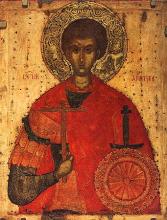26 October/8 November
 Demetrius’ parents, who were Christians in secret, baptized him and instructed him in the Faith. His father, a Roman proconsul, died just as Demetrius came of age. Emperor Maximian Galerius, who ascended the throne in the year 305, appointed Demetrius to his father’s post as governor and military leader of the Province of Salonica. Demetrius’ chief responsibility was to defend the province from foreign enemies, but the emperor also demanded of him that he exterminate the Christians. Instead, Demetrius began to root out pagan practices, and to turn pagans to the Christian Faith.
Demetrius’ parents, who were Christians in secret, baptized him and instructed him in the Faith. His father, a Roman proconsul, died just as Demetrius came of age. Emperor Maximian Galerius, who ascended the throne in the year 305, appointed Demetrius to his father’s post as governor and military leader of the Province of Salonica. Demetrius’ chief responsibility was to defend the province from foreign enemies, but the emperor also demanded of him that he exterminate the Christians. Instead, Demetrius began to root out pagan practices, and to turn pagans to the Christian Faith.
Of course, the emperor was soon told that Proconsul Demetrius was a Christian. Returning from a campaign against the Sarmathians, a tribe that lived in the steppes bordering the Black Sea, Maximian stopped in Salonica Preparing himself for death, Demetrius gave away all his estate to the poor, and immersed himself in prayer and fasting. The Emperor cast the Proconsul into a dungeon, and began to entertain himself and the residents of Thessalonica with gladiator contests at the circus. Christians were pursued and cast into the arena. Leo, a renowned and ardent gladiator, easily defeated the meek Christians in combat, and to the cries of the brutal mob, threw them onto the soldiers’ spear points.
A Christian youth named Nestor visited Demetrius in prison and received his blessing to go out in single combat with Leo. Strengthened by God, Nestor defeated the proud gladiator and threw him onto the soldiers’ spear points. While, as victor, he should have been rewarded, instead he was executed for being a Christian.
In the year 306, at the order of the emperor, prison guards speared Demetrius to death. Great Martyr Demetrius’ body was thrown out to be eaten by wild beasts, but Thessalonians secretly committed him to the earth. Demetrius’ servant Lupus took his bloodied cloak and his ring, and with them began to heal the sick. He was likewise put to death. During the reign of Emperor Constantine the Great (324-337) a church was erected over the grave of Great-Martyr Demetrius; one hundred years later, his incorrupt relics were discovered. Miraculous wonders and healings occurred above his grave. During the reign of Emperor Mauricius, the Avars, who lived along the Don River, besieged the city of Thessalonica. St. Demetrius appeared on the city wall, and the 100,000 man army besieging the city was put to flight. The account of St. Demetrius’ life tells us that he would free prisoners from the bonds of non-believers, and would help them reach Thessalonica.
In the 7th Century, contemporary accounts related that aromatic and miraculous myrrh had begun to flow from St. Demetrius’ reliquary. Writing in the 14th Century, Demetrius Chrysologus stated that the myrrh “in quality is not like water, but is thicker than water, and does not resemble any of the substances known to us... It is more remarkable than any other fragrances – not only artificial ones, but also any natural ones of God’s creations.” For this reason, Great Martyr St. Demetrius is known as “the Myrrh-streaming.”
